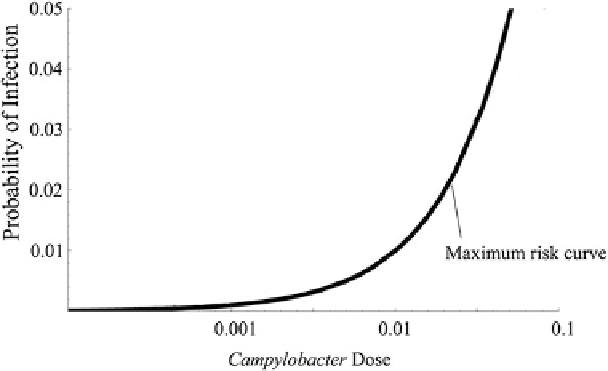Environmental Engineering Reference
In-Depth Information
concentration and an
ed coverage, the event
concentration is ignored). Baseline concentration is given by the proportion
“
event
”
concentration. (In this simpli
μ
,
which is the mean probability density of a given pathogen.
Step 2 is the treatment stage. Here, we need a measure of how many microor-
ganisms
or evade the treatment barrier(s). Let the removal performance be
represented as the proportion
“
pass
”
,
then we get a measure of the density of pathogens in the treated water entering the
distribution network of pipes. But de
π
. If we multiply
π
by the measure of concentration,
μ
ciencies in the pipes might lead to some
addition of more pathogens. This additional intrusion of pathogens is sometimes
due to water-hammer (unequal pressure inside and outside the pipe), due to some
imperfections in the pipes, or simply due to the old age of the pipe. Figure
6.4
refers
to this intrusion into the pipes (
μ
ingress)
simply as
“
ingress
”
is the volume of
water consumed, multiplied by the total pathogen concentration. This gives the
“
The next step is water consumption. The
“
dose of pathogens
”
”
which depends on the mean pathogen density and the number of organisms,
n. Assume that the mean density can be represented by the Poisson distribution.
When infected water is consumed,
dose
-
response.
”
After that we need to estimate the
“
probability of infection,
is defenses might stop some
pathogens. So, we now need the probability of the number of organisms that
successfully overcome the defenses. This should be a Binomial distribution: you are
either infected or not infected.
Next, the probability of infection depends on the probability of exposure to the
number of infections and the number of organisms, given the pathogen removal,
the body
'
.
Next, we need an equation predicting the number of infections from multiple
exposures. So far our prediction for the number of infections is a daily prediction.
μ
Fig. 6.4 Campylobacter and maximum risk dose
-
response curves at low doses (Petterson et al.
2006
)

Search WWH ::

Custom Search